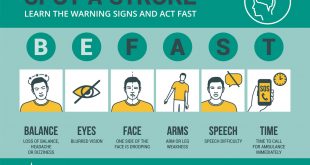

These are the muscles that connect to your bones and contract to allow your arms and legs to move and make breathing possible. The muscles that are most affected include the eyes/eyelids, facial muscles, and the muscles that control chewing, swallowing, and talking.
According to the Johns Hopkins Medical website, the most common symptoms include:
• Visual problems, including drooping eyelids (ptosis) and double vision (diplopia)
• Muscle weakness and fatigue may vary rapidly in intensity over days or even hours and worsen as muscles are used (early fatigue)
• Facial muscle involvement causing a mask-like appearance; a smile may appear more like a snarl
• Trouble swallowing or pronouncing words
• Weakness of the neck or limbs1
How is myasthenia gravis diagnosed?
A doctor can diagnose myasthenia gravis based on symptoms and various tests. One common way to diagnose myasthenia gravis is to test how you respond to certain medicines. Muscle weakness often dramatically improves for a brief time when you are given an anticholinesterase medicine. If you respond to the medicine, it confirms myasthenia gravis.
Other tests that may be done include:
• Blood tests. These tests look for antibodies that may be present in people with myasthenia gravis.
• Genetic tests to see if there is a family history related to the disease.
• Nerve conduction studies. A test called repetitive nerve stimulation is used to diagnose myasthenia gravis.
• Electromyogram (EMG). A test that measures the electrical activity of a muscle. An EMG can detect abnormal electrical muscle activity due to diseases and neuromuscular conditions.1
Treating myasthenia gravis
There is no known cure for myasthenia gravis. However, available treatments can control symptoms and often allow you to have a relatively high quality of life.
There are several therapies available to help reduce and improve muscle weakness, including:
Thymectomy—An operation to remove the problematic thymus gland can reduce symptoms, possibly by rebalancing the immune system. Stable, long-lasting complete remissions are the goal of thymectomy and may occur in about 50 percent of individuals who undergo this procedure.
Monoclonal antibody—A treatment that targets the process by which acetylcholine antibodies injure the neuromuscular junction.
Immunosuppressive drugs—A group of drugs that improve muscle strength by suppressing the production of abnormal antibodies, such as prednisone, azathioprine, mycophenolate mofetil, and tacrolimus. The drugs can cause significant side effects and must be carefully monitored by a physician.
Plasmapheresis and intravenous immunoglobulin—Therapies that are used in severe cases of myasthenia gravis to remove destructive antibodies that attack the neuromuscular junction, although their effectiveness usually only lasts a few weeks or months.
Intravenous immunoglobulin is a highly concentrated injection of antibodies pooled from many healthy donors that temporarily changes the way the immune system operates. It works by binding to the antibodies that cause myasthenia gravis and removing them from circulation.2
Paragon Healthcare
At Paragon Healthcare, we support the Myasthenia Gravis (MG) community through infusible therapies such as immunoglobulin (Ig), Soliris, Ultomiris and Vyvgart. Nationally, our infusion centers treated nearly 1k MG patients during April 2023 and more than 3.5k year-to-date. This puts us in a place to serve as many MG patients this year as the nearly 10k patients we supported in 2022.
A nationwide leader for more than 20 years in infusion care, Paragon specializes in immunoglobulin therapy through our IV Anywhere approach. As a key therapy to help manage myasthenia gravis, we offer Ig through either home infusion or our infusion centers. Providing exemplary care to our lg patients through flexibility in treatment locations, clinical education and access to affordable solutions is vital.
Specifically, we:
• Created a Center of Excellence team with Ig-certified pharmacists and intake specialists. This team assesses each patient individually and educates patients and their physicians on our multiple Ig brands to ensure optimal clinical outcomes and broader access.
• Provide options for Subcutaneous Immunoglobulin Therapy (SCIg) and Intravenous Immunoglobulin Therapy (IVIg), including an in-home nursing
support program for patient education, to offer more flexibility.
• SCIg is administered under the skin and can benefit patients with IV access challenges, prior adverse reactions to IVIg and specific lifestyle needs. IVIg is administered into a vein and offers patients registered nurses to infuse and monitor their therapy at our infusion centers.
• Work with most insurance providers, including Medicare and Medicaid, and connect eligible patients with financial assistance programs—the two most common challenges for Ig patients. Additionally, we review and help with benefits, prior authorizations, internal and external patient assistance programs and more.
As immunoglobulin therapy aids multiple conditions beyond MG, our team treats Ig patients of all ages from children to seniors across specialties including dermatology, hematology, infectious disease, neurology, primary immune deficiency, rheumatology, secondary immune deficiency and transplant.
Learn more about IV Anywhere in FL.
www.paragonhealthcare.com
1. Myasthenia Gravis (2023) Myasthenia Gravis | Johns Hopkins Medicine. Available at: https://www.hopkinsmedicine.org/health/conditions-and-diseases/myasthenia-gravis.
2. Myasthenia Gravis, National Institute of Neurological Disorders and Stroke. Available at: https://www.ninds.nih.gov/health-information/disorders/myasthenia-gravis
 Southwest Florida's Health and Wellness Magazine Health and Wellness Articles
Southwest Florida's Health and Wellness Magazine Health and Wellness Articles

